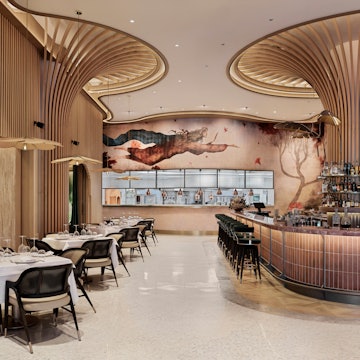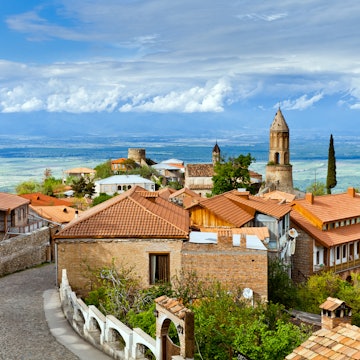
A traveling foodie shares 5 of the world's best cooking classes

Apr 20, 2024 • 9 min read

Food writer, Malia Yoshioka, shares her guide to the world's best cookery courses © Anna Ewa Bieniek / Shutterstock
A cooking class booked in the first few days of your trip is the best way to get acquainted with a new destination.
You’ll whet your appetite and set yourself up for everything else you will see, taste and experience during your trip. You can get restaurant recommendations from an expert to avoid tourist traps and you may even be invited into a local home. If you’re traveling solo, you will meet like-minded travelers. It’s true what Julia Child said: “People who love to eat are always the best people.”
Get curious and don’t be afraid to ask questions. Is this dish eaten often or just for special occasions? Does your host have a special twist or substitution that they make to the classic recipe? What comfort foods did they eat growing up? Who was the best cook in their family? Where’s the best place to get coffee tomorrow morning?
I’ve made it a point to take cooking classes all over the world as a part of my travels, and I find that I usually come away with so much more than just the recipes. Here are a few of my favorites.

Learn layers of history through Turkish dishes in Istanbul with Cookistan
Before our cooking class with Cookistan, we walked through the neighborhood of Kurtuluş. Though it's off the beaten path for most visitors to Istanbul, it is a perfect introduction to shopping and eating like a local in the city.
Our guide, Aysin, weaved in details about the first occupants of the area – a Greek shipbuilding community – and the various multicultural inhabitants who still maintain shops there. We stopped in front of a butcher specializing in offal cuts, complete with sheep’s heads in the window, an illustration of how all parts of the animal are utilized – nothing here is wasted. She explained how people cook with the seasons in Türkiye as we stopped in to pick up artichokes from two men cleaning off a huge mountain of fresh ones in their shop. We salivated over counters of meze, pickles, jams and olive oils and I realized my stomach was growling.
The dishes prepared in the course give Aysin and her instructors a way to speak about various aspects of Turkish cuisine. Dolma (vegetables and grape leaves stuffed with rice and meat) are an example of Anatolian home cooking, for example. Zeytinyagli enginar (artichoke braised in olive oil) represents a popular style of braised olive oil dishes. Circassian chicken, one of my all-time favorite meze, allowed Aysin to explain Türkiye’s meyhane (tavern) culture and how drinks and food go together over a shared table.
Ready to explore Istanbul? Get to know the city one neighborhood at a time with our guide

Make sushi and have a tea ceremony in Tokyo with Yukiko
One of my most memorable classes was in a suburb of Tokyo with Yukiko, who generously opens her home to guests for a taste of true Japanese culture. Leaving our shoes at the door, we entered the cozy living room, complete with family photos, the household altar and traditional shōji (sliding rice-paper screen doors). I instantly relaxed into the invitation to leave the busy city outside, to slow down, be present and enjoy.
Over the course of the class, guests learn a variety of styles of sushi and the proper way to prepare and cool the sushi rice. When it comes to food, anyone who has been to Japan will know that presentation is of utmost importance. Yukiko is also a vegetable sommelier so the delicately cut vegetables really steal the show. We enjoyed playing with small details in color and textures, such as the crunch of a fresh radish, tangy pickles, strips of red cabbage, and the delicate shiso leaf placed under a rice ball. Being able to see the process behind each piece made it much more meaningful every time I ordered sushi after the class, both on my trip and at home.
Perhaps most special of all, you are invited to dress in traditional kimono and to take part in a Japanese tea ceremony, with Yukiko explaining the proper etiquette and meaning behind every step. She is such a calm presence in her style of teaching, always smiling and warm, and genuinely pleased to help foreigners learn about Japanese cooking and culture.
Tempted by sushi and tea? Here are Japan's best food and drink experiences

Follow pasta and tiramisu recipes in Milan with Pasta Pietro
With just 24 hours on a recent trip to Milan, when searching for a cooking class, I wanted to be sure that I was getting both a meal and some entertainment. This led me to the fabulous Pasta Pietro, born and raised in Milan! Pietro is a character, and you can see on his social media his love for the pastas of Italy. You’ll also often see cameos by his adorable twin boys and his mother, who taught him the recipes for the pasta and tiramisu that we’d be making in class.
The eight participants gathered around a long table with the supplies we’d need to be churning out our own masterpieces and the casual setting gave us the feeling of being at a dinner party with food-loving friends. I was tasked with making a simple dough, mixing in flour from the sides into the egg well and letting the dough come together. We rolled out sheets of the pasta and cut them into round shapes. Pietro came through doling out jokes and anecdotes, to adjust our technique or demonstrate the rolling for our cavatelli.
By the end of the preparations we were all laughing as we helped to clear off the dishes and set the table, pasta boiling away on the stove. Finally, we sat down to finish off our tortelli with fresh parmesan cheese and wash it down with a glass of prosecco and our individual cups of tiramisu. We left with recommendations for the next time, new friends and full bellies.
Want to buy some treats while in Milan? Check out these top independent shops

Learn how to make khinkali and khachapuri in Tbilisi
One of the most interesting things you’ll notice about the Georgian capital of Tbilisi are the beautiful, intricately carved balconies and hidden courtyards that you’ll pass, especially walking through older neighborhoods. So I was thrilled to find a cooking class in the old Sololaki neighborhood where we were able to actually walk up through one of these courtyards and into our new Georgian granny’s home for the afternoon.
The dining table was set up and Irina put the four of us right to work, chopping up herbs and onions for the filling for our khinkali (meat dumplings). We were able to learn about the different styles of khinkali – some don’t contain herbs as we were using – and it was interesting to learn the variations for future reference when confronted with choices on a menu. We learned tips along the way like how to judge the amount of water to add to the ground beef filling to be sure that the dumplings would have “soup” once boiled. The pace of the class was great and we all enjoyed focusing on our own folding skills when it came to preparing the actual dumplings.
We were so proud of our handiwork with the dumplings that we nearly forgot that we still had another dish to make – the famous boat-shaped Adjaruli khachapuri – a cheesy bread topped with butter and an egg yolk that you mix in just before eating. Again, this was just one of the regional variations of khachapuri and learning about the differences allowed us to seek out and try the others during our trip.

Create delicious khăo soi in Chiang Mai with Baan Thai Cookery School
Before going to Thailand, my experience with Thai dishes were from the basic red, green and yellow curries that I’d tried in Thai restaurants, or the ubiquitous pad thai noodles. Once I actually found myself wandering the streets in Bangkok, where these dishes were daily fare rather than a special occasion restaurant, it was eye-opening for me and I became excited to try something new.
We started off our Baan Thai cooking class with a market tour and despite her tiny frame and oversized smile, our guide’s sing-song voice carried over the busy market stalls as we gathered ingredients and took them back to the class. There, the scent of freshly ground spices, chiles, lemongrass, turmeric, and ginger danced together in the fragrant spice mix of the curry. It was my very first cooking class and I simply loved the practicality of it all. Not only would we get a delicious meal out of the experience, but spend time with a local chef and learn about the ingredients in our favorite dishes too.
My favorite from our course was a regional specialty called khăo soi, a coconut curry dish with egg noodles from northern Thailand that I probably wouldn’t have ordered otherwise, preferring to stick to the things that I knew before. It was this class that set me off on my love of cooking classes around the world.
Need more inspiration? Here are Thailand's top food experiences
How to make the most of your perfect cooking class
Use your research to learn about what foods are popular or most representative of your destination and get curious about why. Look into the ingredients and spices, and take lots of notes!
Opt for companies that are indigenous-run when possible, or led by locals with a deep connection to the place. I often will read the background of the chef in the listing itself and/or the comments by past participants in order to get an idea of what to expect. A local will be able to give you well-rounded recommendations for the rest of your stay as well.
Consider a tip if you’re pleased with the experience. I’ve often felt that the classes I booked were worth way more than what I paid, so I often try to leave an additional gratuity if possible.
Connect and engage with your host on social media and ask them to point you towards other local food blogs, cookbooks or websites that you can follow to continue to learn about your destination.
If you’re a language lover, food is the perfect introduction to learning a bit of the language on your trip. At a minimum, learn how to say “thank you” and “it’s delicious,” but if you’ve got more time, you can learn words for vegetables, meat, and flavors that will help you decode restaurant menus or on a trip to the supermarket. I sometimes will even buy a cookbook in the language of my destination and use that to learn cooking verbs like “add”, “fry” or “bake,” or measurements like cups or teaspoons.













